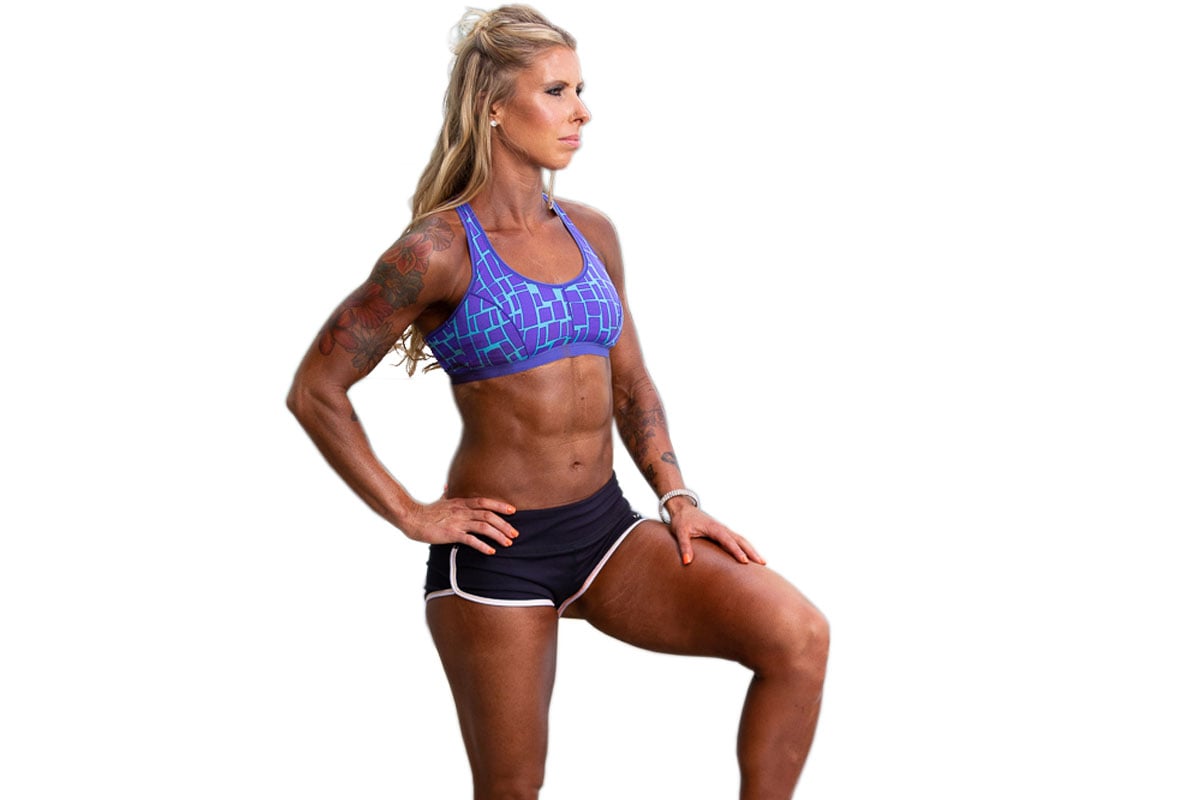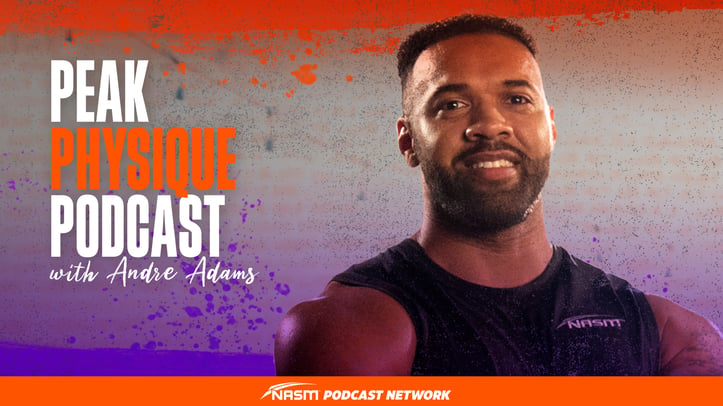"Most of my training in my adult life has been with the Phase 3 guidelines. I just didn’t know it until I became certified with NASM 15 years ago,” says Aaron Guy, NASM-CPT, CES, PES, FNS, and competitor with the National Physique Committee. “Hypertrophy is my favorite style of training.
I tend to spend a lot of my year within those parameters.” That should come as no surprise: Guy and the other two experts who were consulted for this article are professional competitive bodybuilders, as well as Master Trainers for NASM.
Megan Johnson McCullough, NASM-CPT, is additionally an NASM Master Instructor, an AFAA group exercise instructor, a fitness writer, and a doctoral candidate in health and human performance. She began lifting weights in high school because, as she explains, “my superstar role models in the NBA did it.” But she had no guidance or training, even as a basketball player at the collegiate level.
“I’m sure I got quicker, faster and stronger, but there was no real measure of this,” she says. “Had I known the OPT model, maybe I would have gone pro, right?” Eventually, of course, she did go pro—as a natural bodybuilder.
For McCullough and NASM-CPT Andre Adams, the NASM OPT™ model provides the structure and acute variables needed to achieve a specific result, which, in their case, is often maximum muscle enlargement.
“As a professional bodybuilder [with the International Federation of Bodybuilding and Fitness], I use these methods and adapt them to my specific goals to balance an aesthetic competition look with functional health and overall well-being,” says Adams, who also holds the NASM PES, FNS, WFS and WLS specializations; is well-known in the fitness industry; and is sponsored by supplement maker 1st Phorm.
Here, these three experts on hypertrophy training share their best practices to help you adapt the NASM OPT model to suit your own needs and those of your clients.
You can apply everything you learn in this blog post and have a jump start on a bodybuilding specialization with NASM if you choose!
Making Gains in the Offseason
When Guy was competing more regularly, he followed NASM’s guidelines for hypertrophy fairly closely (see “Summary of Phase 3: Muscular Development Training,” below). “I did 3 sets of 10 reps of an exercise, often increasing the weight until the third set, where I could safely get between 6 and 10 reps,” he says. Sometimes Guy’s rest periods exceeded the 60 seconds, particularly with a “more demanding exercise” such as a squat or deadlift.
During the offseason, Guy also added Phase 4: Maximal Strength training to his workout for about 4–6 weeks. This helped him increase his 1-repetition max and, in turn, his weight loads during the precompetition training, in which his goal was to improve size and symmetry.
“I rarely cycle to Phase 5, because power and athletic training aren’t my end goals,” says Guy, who is also certified as a Level 1 Sports Performance Coach with USA Weightlifting and KettleBell Concepts. “But I do enjoy some explosive exercises and superset them with strength-based training from time to time.”
Adams also cycles through various phases of the NASM OPT model to make gains in size and strength (see “Andre Adams’ Offseason Training Plan,” below). “In my offseason, I change my routines up every 4–6 weeks, floating between Phases 3, 4 and 5, because I really enjoy lifting heavy and packing on size,” he says.
McCullough, too, adds some Phase 4 work in the offseason (though she notes there really isn’t an offseason in bodybuilding), but her focus in Phase 3 training is on volume and intensity.
“I use progressions to continuously challenge my body. This means heavy lifting that increases in load with each set but also increases over time,” she says. “As a natural bodybuilder, it’s hard work and eating [right] that generate results. Even more so, it’s patience. Muscles take their time growing, but it’s the constant, persistent and sheer drive to win—day after day, workout after workout—that adds up.” (For variety, check out this blog on drop sets.)
See also (if you want to maximize your gains): Recipes for Gaining Muscle
1. Getting Competition-Ready
In the month leading up to a competition, Guy and Adams both focus almost entirely on Phase 3 training while adding cardio work and making major changes in food choices and caloric intake. The goal here, of course, is to shed body fat and get lean without losing muscle gained previously.
While the men maintain this routine throughout competition prep, McCullough finds that her dietary restrictions eventually sap her of the stamina and energy needed for muscular development training.
“At this point, the work is done, and Phase 1: Stabilization and Phase 2: Strength Endurance exercises are my savior,” she says. “They help me keep the muscle I’ve gained, feel like I can survive the workouts, and attain the lean, symmetrical shape I’m aiming for. It sounds silly, but after the body has been pushed, going back to Phase 2 is a comfort zone. I’ve climbed the ladder to the top of the phases, and now I get to relish the reflection I see in the mirror while literally ‘enduring’ through the final weeks.”
For his part, Adams notes that this is not the time to go for gains. “I try to maximize blood flow and nutrient delivery without the added inflammation or stress of lifting extremely heavy weights,” he says. “During that ‘cutting phase,’ I change up my exercises and nutrition plans every 2 weeks while staying within the structure of NASM OPT Phase 3.”
2. Tackling Plateaus
“Hypertrophy/Muscular Development training is not an overnight process,” says McCullough. “I need 4–6 weeks to fully let my muscles experience the right amount of overload gradually, safely and effectively.” By week four, she says, it’s time to switch things up.
“By then, I’ve just about capped out at the weight,” she says. “I need to challenge myself with new exercises.”
That’s good for her psyche, not just her physique. “At this point, I have developed a love-hate [relationship] with whatever I’m doing,” she explains. “I’m at my max, so it’s mentally hard to keep at it, and I’m bored. Not to mention I wake up at 3:45 a.m. to get my training in, so I have to look forward to what I’m doing.”
When Guy feels he is beginning to plateau, he adds new exercises, too, or changes up the order of his split routine. Though he used to focus mainly on bilateral exercises done with machines and free weights, targeting one body part per day, he recently compacted the program, working on a pair of muscle groups each day for challenge and efficiency.
As for Adams, he taps into his favorite “shocking” techniques, such as power lifting, partial-range repetitions and high-volume, high-frequency training. “Our bodies are always in a state of adaptation, so I change things up every 2–4 weeks,” he says.
Letting the calendar trigger changes can be okay for yourself, notes Adams, but with clients, communication is key to knowing when a change is required. “Closely monitoring your clients’ progress will help you identify how they are feeling,” he says.
Read also: Back to Basics Hypertrophy Training
3. Addressing Compensations and Injuries
A short time ago, Guy received a diagnosis of femoroacetabular impingement (extra bone growth at the hip joint). It humbled him—and showed him the importance of cycling through the full range of the NASM OPT model.
Working with a physical therapist and using his own CES training, Guy rounded out his routine to address existing compensations and allow for recovery and healing. His new workout (below) includes many additions: more core and balance training, as well as light cardio, active stretching and self-myofascial release. “Foam rollers generally aren’t enough to get into my soft tissue,” he notes, “so I use more aggressive
A few weeks into this new program, Guy’s pain decreased enough that his need for anti-inflammatories became almost nonexistent. “This experience made me understand how my clients feel when dealing with the psychological and physical aspects of treating injuries,” he says. It also has him sold on including more Phase 2 training throughout the year.
Says McCullough, “When the kinetic chain needs some work, individualized programming needs to be done to make sure heavy lifting is implemented safely and correctly.” For the past 2 years, she has been working to address some of her own compensations caused by an old college injury.
“Following an ACL and meniscus tear from college basketball, my glutes and hamstrings were weak, which made my gluteus medius and lower back take the brunt of squatting,” she says. After plenty of hard work—training on machines in a fixed axis (such as the leg press) and “relentless single-leg touchdowns”—she can now perform a barbell squat with proper technique and “enough load to be effective.”
Adams notes that using the assessments recommended by NASM can be helpful in identifying and avoiding injury, but it can also allow the fitness professional to address another consideration related to hypertrophy: aesthetics.
Programming With Aesthetics in Mind
“There are many acute variables that are customized for each athlete depending on his or her personal strengths and weaknesses,” says Adams. “For example, I might start with our standard overhead squat assessment to identify muscle imbalances and mobility challenges.
But this must also be integrated with the athlete’s specific goals, which will include aesthetics. For example, if the athlete has dominant quads and is lacking strong hamstrings and glutes, then the approach is slightly different to address both overall well-being and aesthetic competition–related goals.”
For McCullough and other female bodybuilders, aesthetics often comes with an added layer of challenge: the societal judgments that are frequently directed at fit women. Her advice? Be persistent and ignore the unsolicited commentary. “When it comes to females, if you want muscles, ignore the scale, ignore the stereotypes and start lifting,” she says. “My look is still natural, feminine and athletic.”
Taking Time for Rest and Recovery
When this trio was asked what else to keep in mind with hypertrophy training, the answer was unanimous: recovery. This begins with proper fueling.
McCullough recommends “real, clean food.” She adds, “The tear down of fibers needs to be given the right environment to grow and repair.”
“If eating right after a workout is hard for you, as it is for me,” says Guy, “try a protein supplement to tide you over until your next meal.” Adams takes this one step further, noting that, for him, supplements provide the most efficient refueling method after an intense workout during his “growing phase.”
Of course, recovery also means giving muscles time to use those nutrients to make necessary repairs and gains. “I sometimes train my aesthetic weak points on off days,” says Adams, “but mostly I recommend you eat and rest and try to reduce inflammation [before] the next intense training week.”
Read also: Active Recovery - Rest Days, Workouts, Exercise Examples
After a particularly intense muscular development session, however, it’s Guy’s specific recommendations that may be most welcome. “Take some time to pamper yourself. Get a massage. Try some acupuncture. Do something that brings you happiness and helps you relax,” he says. “You work out hard. Treat yourself from time to time.”

Summary of Phase 3: Muscular Development (hypertrophy) Training
These are the NASM OPT Model Phase 3 acute variables for resistance exercises in hypertrophy and muscular development training. However, as our experts can attest, it is also important to pay attention to the flexibility, core, balance, plyometric and SAQ guidelines offered in NASM Essentials of Personal Fitness Training, 6th ed. (Jones & Bartlett Learning 2018). Generally, the frequency recommendation for muscular development training is 3–6 times per week, with 2–4 strength exercises per body part.
- 3–5 sets
- 6–12 reps
- 2/0/2 tempo
- 75%–85% intensity
- 0- to 60-second rest interval
Andre Adams’ Offseason Training Plan

Adams says his 12-week offseason training cycle might look something like this:
Weeks 1–2: Phase 3
Weeks 3–4: Phase 4
Weeks 5–6: Phase 5
Weeks 7–8: Blend of Phases 3–5
Weeks 9–10: Blend of Phases 3–5
Weeks 11–12: Phases 1 & 2 (de-load)
Megan McCullough’s Upper-Body Drop Set

Have you run the rack? To bust through a plateau and make great gains, try “Megan’s Trio.” Choose three sets of dumbbells in 5-pound increments; for example, 30, 25 and 20. Do the following moves 8–12 times with the heaviest dumbbells, then repeat the entire sequence with successively lighter weights (“run the rack down”).
- standing overhead pressstanding or seated biceps curlone-arm row (knee on bench)
Aaron Guy’s Post-Injury Approach

After being diagnosed with hip impingement, Guy modified his routine with the help of his physical therapist. Guy now does slow, controlled light cardio (with as little hip flexion as possible) and performs strength exercises with lower weight and controlled movement. These are some of the moves he added:
balance: single-leg balance and reach
core: glute bridges (single and double leg)
gluteus medius and abductors: lateral tube walking frontal-plane stability: single-leg Romanian deadlifts
legs: single or double closed-chain exercises with very low weight and Bulgarian split squats (replacing traditional split squats)
The Lowdown on Low-Load Blood Flow Restriction
LL-BFR training—also called occlusion training and KAATSU®—has been used in clinical rehabilitation settings for years among populations with functional deficits preventing the use of high mechanical loads. Among healthy athletes, it has served for decades as a means of gaining strength and hypertrophy. KAATSU, in fact, has been used since 1966, when Japanese researcher Yoshiaki Sato first invented it. (In Japanese, ka means “additional” and atsu means “pressure.”)
A 2016 review of 12 papers on BFR in athletes concluded that LL-BFR can result in gains in strength and hypertrophy in well-trained athletes (Scott et al. 2016). That same year, results from a questionnaire on the use of BFR for a wide variety of reasons (including hypertrophy, but also for depression and arthritis) reported safe, beneficial results with no serious side effects, regardless of age, gender or physical condition (Yasuda et al. 2017).
Further, a 2018 meta-analysis and systematic review of the effects of LL-BFR versus conventional high-load resistance training showed that both methods produced similar gains in muscle mass “regardless of the absolute occlusion pressure, cuff width, and occlusion pressure prescription” (Lixandrão et al. 2018).
As more research is done on BFR, fitness professionals may want to further investigate the benefits, drawbacks and applications of this technique, especially if clients are inquiring about BFR use for muscular development.

REFERENCES
Lixandrão, M.E., et al. 2018. Magnitude of muscle strength and mass adaptations between high-load resistance training versus low-load resistance training associated with blood-flow restriction: A systematic review and meta-analysis. Sports Medicine, 48 (2), 361–78.
Scott, B.R., et al. 2016. Blood flow restricted exercise for athletes: A review of available evidence. Journal of Science and Medicine in Sport, 19 (5), 360–67.
Yasuda, T., et al. 2017. Use and safety of KAATSU training: Results of a national survey in 2016. International Journal of KAATSU Training Research, 13 (1).
















